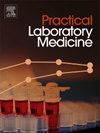Rapid identification of daratumumab interference with M-protein detection using MALDI-TOF mass spectrometry: a case study involving renal light chain amyloidosis
IF 1.7
Q3 MEDICAL LABORATORY TECHNOLOGY
引用次数: 0
Abstract
Therapeutic monoclonal antibodies (t-mAbs), such as daratumumab (anti-CD38), are increasingly used in plasma cell disorders including systemic AL amyloidosis. However, their exogenous IgG kappa/lambda components can mimic endogenous monoclonal immunoglobulins in serum immunofixation electrophoresis (IFE), leading to diagnostic challenges. We report a 48-year-old male with biopsy-confirmed lambda-restricted renal AL amyloidosis. After transitioning to daratumumab-CyBorD therapy following CyBorD failure, his serum IFE unexpectedly revealed biclonal bands—a cathodal IgG kappa and anodal IgG lambda—suggesting biclonal gammopathy. Suspecting daratumumab interference (an IgG kappa antibody), we employed mass spectrometry (iMS-LC assay) for definitive analysis. Post-treatment serum showed two distinct peaks (endogenous lambda: m/z 22,718; daratumumab kappa: m/z 23,389), while pre-treatment serum contained only the endogenous lambda peak (m/z 22,716). This confirms daratumumab generates a cathodal IgG kappa band mimicking pathological gammopathy. To prevent diagnostic errors in plasma cell disorder monitoring, laboratories should proactively identify t-mAb interference using historical controls and targeted mass spectrometry.
使用MALDI-TOF质谱快速鉴定daratumumab对m蛋白检测的干扰:涉及肾脏轻链淀粉样变性的案例研究
治疗性单克隆抗体(t- mab),如达拉单抗(抗cd38),越来越多地用于包括全身性AL淀粉样变性在内的浆细胞疾病。然而,它们的外源性IgG kappa/lambda成分在血清免疫固定电泳(IFE)中可以模拟内源性单克隆免疫球蛋白,从而导致诊断挑战。我们报告一位48岁男性患者,活检证实为lambda-restricted renal AL淀粉样变。在CyBorD失败后改用达拉图单抗-CyBorD治疗后,他的血清IFE出乎意料地显示双克隆带-一个阴性IgG kappa和一个阴性IgG lambda -提示双克隆伽玛病。怀疑是daratumumab干扰(一种IgG kappa抗体),我们采用质谱法(iMS-LC测定)进行确定分析。治疗后血清出现两个明显的峰值(内源性lambda: m/z 22,718;Daratumumab kappa: m/z 23,389),而预处理血清仅含有内源性lambda峰(m/z 22,716)。这证实了daratumumab产生一个模拟病理性伽玛病的阴极IgG κ pa带。为了防止浆细胞疾病监测中的诊断错误,实验室应使用历史对照和靶向质谱法主动识别t-mAb干扰。
本文章由计算机程序翻译,如有差异,请以英文原文为准。
求助全文
约1分钟内获得全文
求助全文
来源期刊

Practical Laboratory Medicine
Health Professions-Radiological and Ultrasound Technology
CiteScore
3.50
自引率
0.00%
发文量
40
审稿时长
7 weeks
期刊介绍:
Practical Laboratory Medicine is a high-quality, peer-reviewed, international open-access journal publishing original research, new methods and critical evaluations, case reports and short papers in the fields of clinical chemistry and laboratory medicine. The objective of the journal is to provide practical information of immediate relevance to workers in clinical laboratories. The primary scope of the journal covers clinical chemistry, hematology, molecular biology and genetics relevant to laboratory medicine, microbiology, immunology, therapeutic drug monitoring and toxicology, laboratory management and informatics. We welcome papers which describe critical evaluations of biomarkers and their role in the diagnosis and treatment of clinically significant disease, validation of commercial and in-house IVD methods, method comparisons, interference reports, the development of new reagents and reference materials, reference range studies and regulatory compliance reports. Manuscripts describing the development of new methods applicable to laboratory medicine (including point-of-care testing) are particularly encouraged, even if preliminary or small scale.
 求助内容:
求助内容: 应助结果提醒方式:
应助结果提醒方式:


